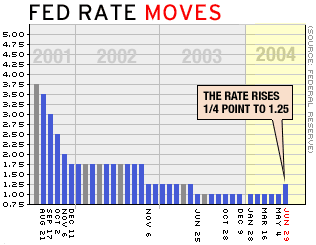NEW YORK (CNN/Money) -
Though July's job report was far weaker than expected, and some of the economy's June soft patch apparently leaked into July, analysts believe the Fed is still likely to raise its key interest rate target this week.
Federal Reserve policy makers meet Tuesday for a sit-down about the economy's strength and where they think interest rates should be.
The Fed policy makers -- and chairman Alan Greenspan -- will be on some very hot seats.
On the one hand, some economists are taking the jobs report and other recent weak economic reports as signs that the economy still needs the stimulus low rates provide.
On the other, the Fed is under pressure from inflation hawks, who worry that the central bank's target overnight interest rate, the fed funds rate, is too low at 1.25 percent, far below the rate of inflation -- effectively flooring the accelerator on the economy and flooding the system with money.
Most analysts and bond market participants believe the hawks' concern will win the day on Tuesday. The fed funds futures contract, a way to measure market expectations of future Fed action, is pricing in roughly a 90 percent chance of a quarter-percentage-point hike. Bucking those expectations could cause bond yields to drop, pumping even more money into the economy.

"The Fed will look at a cross-section of data, which still show that enough vigor in the economy remains to pose a risk for higher inflation," said Anthony Crescenzi, bond market strategist with Miller Tabak & Co. "If the Fed were to hold off on raising rates on Tuesday, they would create additional stimulus for the economy by causing a further drop in other interest rates."
Crescenzi blamed inflation for recent signs of weakness in the economy. For example, gross domestic product (GDP), the broadest measure of the economy, grew at a 6.3 percent annual rate in the third quarter, before adjusting for inflation. Higher prices slashed the "real" growth rate, adjusted for inflation, to 3 percent.
The Fed also has some face-saving to do. On July 21, Greenspan told Congress the economy was hunky-dory and that any "softness" in June data on consumer spending, hiring, manufacturing and just about everything else in the economy was temporary.
Greenspan said the Fed needed to get cracking on raising the fed funds rate and that the economy was ready to handle it. Markets took this as a clear indication that he planned an August rate hike, and a sudden about-face would send the signal that the Fed was wrong and that things are more dire than they looked just weeks ago.
"Greenspan is at risk of losing his credibility, based upon the fact he was so upbeat two or three weeks ago," said Richard Suttmeier, chief market strategist at Joseph Stevens & Co. "If they don't bring rates up at this meeting, he will lose credibility -- that would send a horrible message to markets."
How wide the soft patch?
On the other hand, the Fed can't ignore recent signs of vulnerability in the world's largest economy. Higher oil prices were, in part, to blame for June's slowdown, and they've been setting new records almost daily in late July and early August.
And job growth in July was exceptionally weak, according to the latest Bureau of Labor Statistics report on Friday, the weakest since December, and marked the fourth straight month in which payroll growth has slowed.
Auto sales bounced back from June's slump, but automakers had to offer aggressive incentives to entice buyers back to the car lots. Retail sales weren't anything to write home about.
Meanwhile, recent inflation measures haven't been alarming. The Commerce Department's core personal consumption expenditure index, the Fed's favored inflation gauge, rose at an anemic 1.5-percent annual rate in June, compared with 1.4 percent the year before.
"I don't see how they can raise rates, given what's happening here," said Robert MacIntosh, chief economist at Eaton Vance Management. "They need to see job creation or inflation, and right now we're not seeing much of either."
And, of course, there's the November election. The Bush clan was reportedly unhappy with Greenspan back in the early 90s for not cutting rates aggressively enough, in their view, when the economy was struggling and George H. W. Bush was running for a second term in the White House.
The current President Bush probably won't be thrilled to hear on Tuesday that, amid weak job growth, record-high oil prices and a slumping stock market, the Fed has pitched in with a rate hike.
Of course, the Fed is supposed to ignore such considerations, and it likely will. But that won't make things any cooler in that conference room.
What's more, economists poked sunny holes in the dark cloud of Friday's job report. They noted the decline in the unemployment rate, which is generated by a different survey than the one that creates the payroll number, a survey that showed some 629,000 new jobs created in July. They pointed out that wages and hours worked rose.
"The report, although on surface very weak, has within it other elements that suggest the economy is not falling apart," said former Fed Governor Lyle Gramley, now a consulting economist with Schwab Washington Research. "The odds are better than 50/50 that they will move up a quarter [on Tuesday], on the grounds that this slowdown is likely to be transitory."
But Gramley and other economists noted that, if weak data keep rolling in, future Fed hikes could be on hold, and other rates could rise more slowly -- or not at all.
"Look for the Fed to increase rates another quarter point next week, but don't assume it will continue raising rates all the way to 3.5 percent," said Peter Morici, professor at the Robert H. Smith school of business at the University of Maryland. "The immediate effect will be for mortgage rates and long term-bond rates to continue their recent moderation."

|